|
An Act of Parliament allowing the
construction of the canal and tunnel, linking the Dudley
Canal with the Birmingham Canal, was passed on the 4th
July, 1785. Work quickly started on the project, under
the supervision of John Pinkerton and Adam Lees, who was
chief engineer. They were assisted by Thomas Dadford.
The tunnel, which is 3,172 yards
long was built with a minimum headroom of 5 feet 9 inches and a width at the
waterline of 8 feet 5 inches. There are two open basins
towards the northern end of the tunnel, Shirts Mill
Basin and Castle Mill Basin. The building work included
the construction of five locks at Park Head, which
raised the canal from its old level to the level of the tunnel and the Birmingham
Canal.
The work at Park Head was carried out by Brown
and Green, a local building firm. John Pinkerton
resigned from the project and Brown and Green agreed to
carry out the remaining work on the tunnel. In 1789 it
was discovered that errors had been made in the original
survey, which made the construction more difficult.
Sadly Brown and Green had financial difficulties and
were declared bankrupt, so the tunnel had to be
completed by local labour, recruited by the company’s
engineers.
In January 1792, the working shafts
not needed for ventilation were closed and in February
the tunnel was open for navigation. The final work on a
shortened link to the Birmingham Canal was completed in
March, 1792. The Birmingham Canal Company insisted on
building a stop lock at Tipton Green because of fears of
losing water to the Dudley Canal. The tunnel opened for business on
the 15th October, 1792. The canal now took a lot of
traffic from the Staffordshire & Worcestershire Canal,
offering a faster route to Birmingham. |
|
Initially limestone was quarried
from the immediate area near the tunnel, but as more of
it was used, work began on the Wren’s Nest Tunnel that
linked Castle Mill Basin to the limestone mines at
Wren’s Nest. It was over half a mile long and was linked
to the mines by many tramways and foot tunnels.
Limestone was blasted from the roof and sides of the
mines in pieces weighing as much as 100 tons, which
would fall to the bottom and break-up into smaller
pieces. The limestone was then loaded onto tramway
wagons and taken to the canal to be loaded onto boats,
which were about 30 feet long by 5 feet 6 inches wide
and could carry about 10 tons of stone.
The boatmen
propelled the boats using long poles pushed against the
tunnel roof, or where space allowed, they would be
"legged" by boatmen lying on their backs and walking
along the sides or roof of the tunnel with their feet.
By the middle of the 19th century,
most of the limestone near the main tunnel was worked
out and so mining became concentrated on Wren's Nest
Hill.
As built, the main tunnel was unlined, but due to
pieces of rock falling from the roof, a brick lining
was added in 1816, except in areas where there was
rock movement due to the many faults in the area. |
 |
| In 1836, stop gates were built at the tunnel ends to
protect boats in the tunnel from accidental loss of
water. In 1845, the Dudley Canal Company was
amalgamated with the Birmingham Canal Company and
the stop lock at the junction of the two canals was
removed. In the mid 19th century the tunnel
was extremely busy. Over 100 boats per day used the
tunnel, carrying coal, limestone, iron ore, timber, clay
and items manufactured in the local factories. Because boats could
not pass each other in the narrow tunnel, a timetable
had to be drawn up and boats went through in convoys
from each end, at certain times. |
|
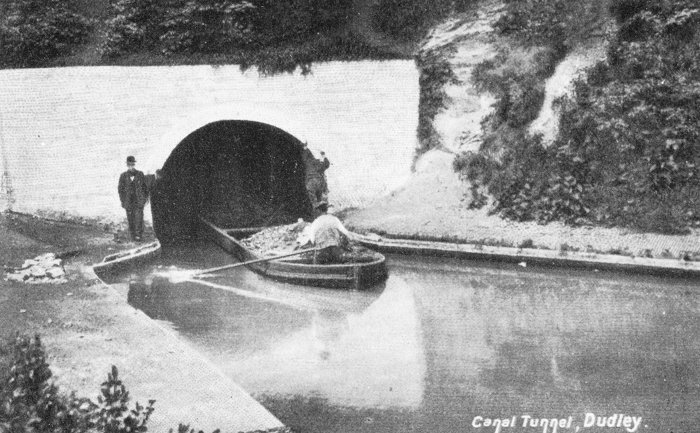
A narrow boat leaving the
Dudley Tunnel. From a postcard posted in 1908. |
|
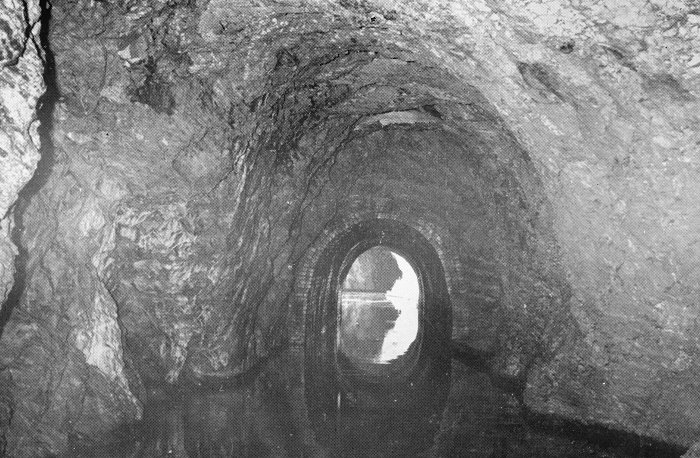
Part of the main tunnel. |
|
In 1858 the Netherton Tunnel opened
with a tow path on either side of the canal so that
boats pulled by horses could go through the tunnel and pass one another. Both tunnels continued to
be heavily used until the later part of the 19th century
when railways began to take trade from the canals. At
this time more of the remaining traffic used the Netherton Tunnel in preference to the narrow Dudley
Tunnel, which had to be rebuilt at the southern end in
1884, due to mining subsidence.
By the 1930s, road transport began
to greatly reduce canal transport and by the early
1950s, less than half a dozen boats passed through the
Dudley Tunnel each week. The numbers rapidly fell and in
1959 British Waterways decided that the tunnel should
close. A protest cruise was held in October 1960, but
in spite of strong protests from canal societies, the
tunnel was officially abandoned by British Waterways in
1962.
|
|

Castle Mill Basin. |
On the 1st January, 1964, a group
of canal enthusiasts formed the Dudley Canal Tunnel
Preservation Society, which soon had several hundred
members.
The society organised trips through the tunnel
and gave talks to other societies and organisations,
also managing to publicise their campaign on radio and
TV. They were eventually acknowledged by British
Waterways and in 1970 became the Dudley Canal Trust.
In 1968, the railway bridge that
passed over the northern end of the tunnel was declared
unsafe and so British Railways decided that it should be
replaced by an embankment that would completely cover
the tunnel.
By the late 1960s, the railway was largely
used for goods and in 1968 it became a victim of the Beeching cuts. It was completely closed and so the
embankment was never built.
People’s attitudes to the canals
were changing and in 1968 the government announced that the
membership of the Inland Waterways Amenity Advisory
Committee (IWAAC), would include members from the Inland
Waterways Association, which campaigned for the
conservation and restoration of the British canal
network. |
|
Many volunteers became involved in the project to
restore the canal and the tunnel to their former glory.
Dudley Corporation became the first local authority to
finance canal restoration, announcing that they would
fund half of the repair costs for the tunnel branch, as
well as landscaping the derelict land at Park Head,
around the southern end of the tunnel. Thanks to help
from British Waterways and Dudley Borough Council,
around 50,000 tons of mud and debris were dredged from
both ends of the tunnel and the locks to the south were
restored.
At Easter 1973, the tunnel was reopened and around
300 boats and 14,000 visitors came to the event. The
trust began running boat trips into the tunnel and a
boat was converted to use a battery-powered electric
motor in 1975. By August 1977, the Dudley Canal Trust
had carried around 25,000 visitors through the tunnel,
but subsidence near the southern end led to its closure in
1979. It took many years to find sufficient funds for
the repairs. Grants from several organisations including
the European Regional Development Fund, totalling around
three quarters of a million pounds, enabled the brick
lining to be removed from a section, 110 yards long and
replaced with a concrete tube. The tunnel reopened in
1992.
|
|
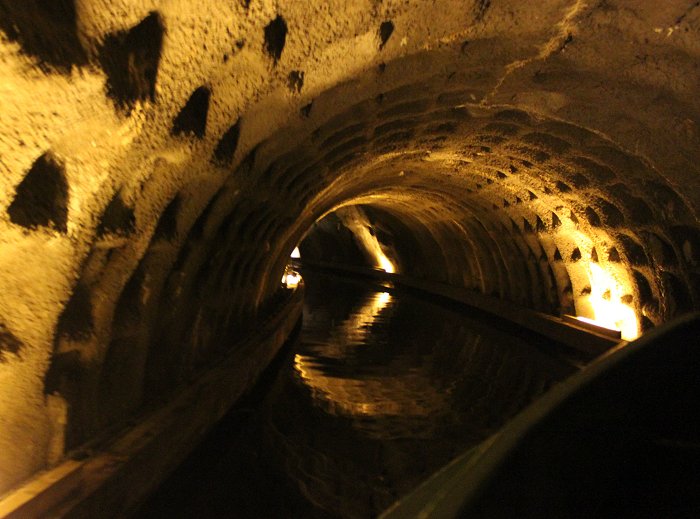
Part of the southern end
of the tunnel. |
|
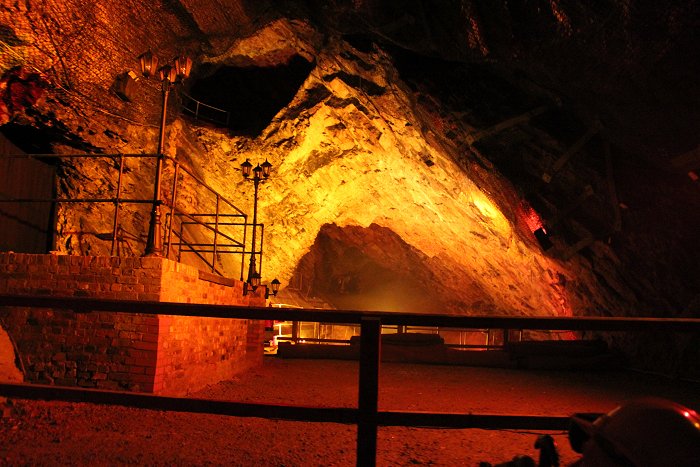
Some of the limestone workings
beside the canal in the Dudley Tunnel. |
|
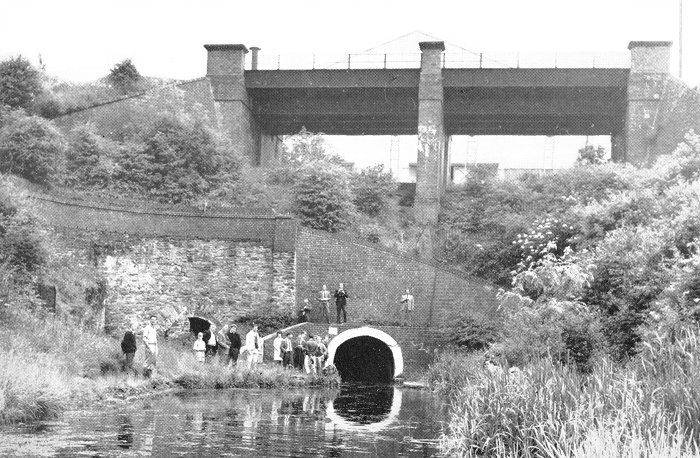
The northern end of the
tunnel. |
| In 1984 a new tunnel was built to provide access to
the Singing Cavern, which was formally opened on the
23rd April, 1985, by Neil MacFarlane and John Wilson. By
1987, work began on an extension
between the Singing Cavern and the Little Tess cavern.
The work involved the excavation of part of the blocked
rock tunnel, along with a new tunnel to link Little Tess
Cavern to Castle Mill Basin. The new route was formally
opened by councillor D. H. Sparkes, on the 25 April,
1990.
In 1996 the trust took-over the disused Blowers Green
Pumphouse and converted it into offices, an education
centre, workshops and stores. It is now used for social
functions and storage.
The tunnel became extremely
popular. By 2004 between 80,000 and 90,000 people were
visiting the attraction each year.
On the 4th March,
2016, the Trust’s new headquarters, the Portal Building,
was formally opened by Princess Anne and the attraction
continues to go from success to success.
|
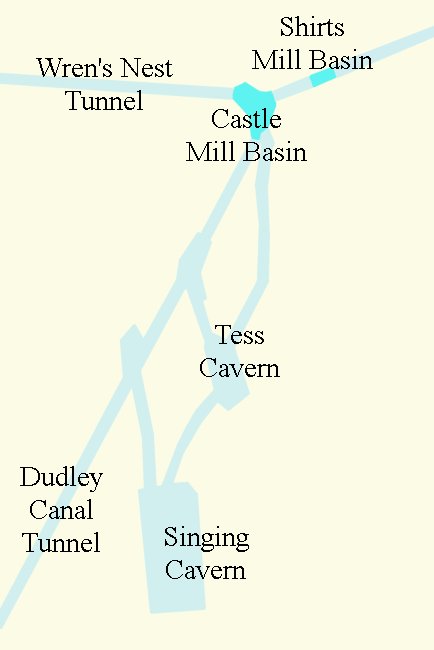 |
 |
Return to the
previous page |
|